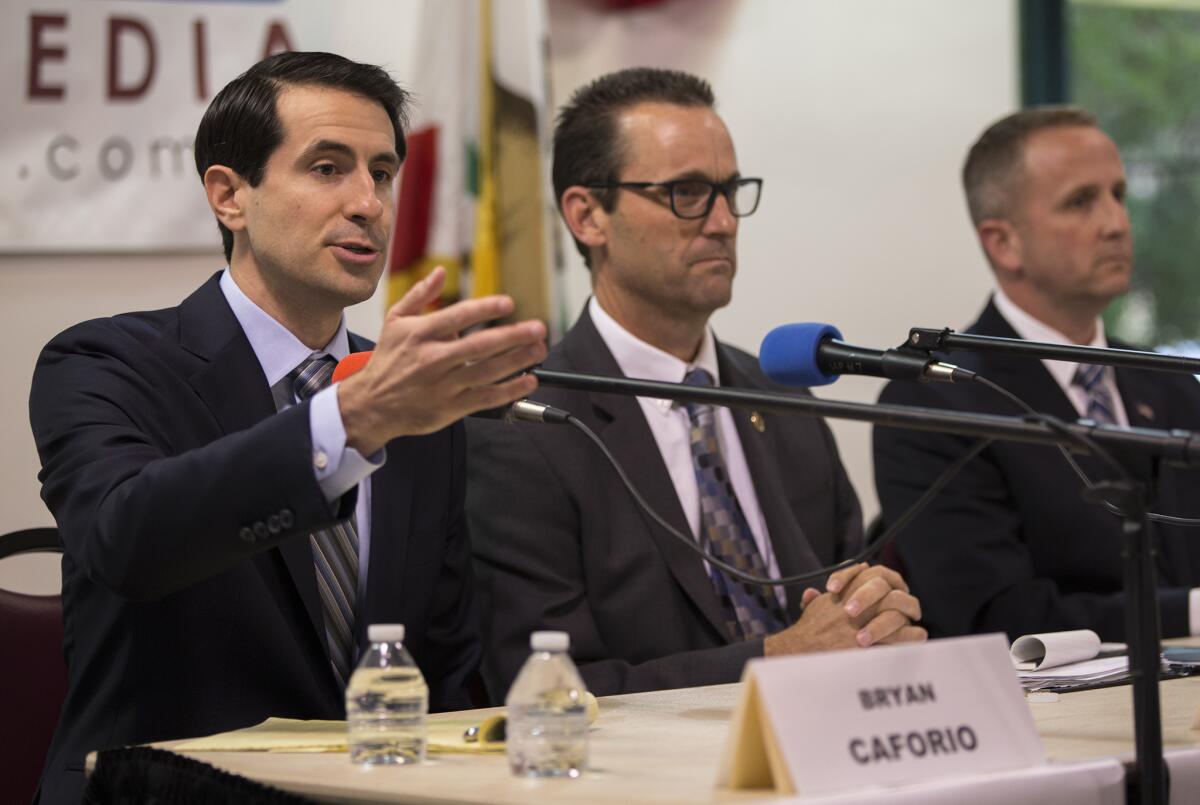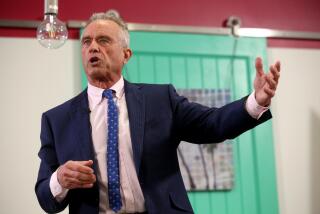Could Democrats win an Antelope Valley congressional seat they haven’t held since 1964?

The last time a Democrat represented north Los Angeles County’s Antelope Valley in Congress it was 1964, the year Rep. Everett G. Burkhalter decided to give up his seat and retire.
That November, Republican newcomer Edwin Reinecke was able to hold back the massive Democratic wave behind President Lyndon B. Johnson and scratch out a surprise victory for the open seat representing the Antelope Valley at the western edge of the Mojave Desert.
Republicans have had a tight grip on the area ever since, as cities such as Palmdale and Lancaster blossomed with the region’s aerospace boom.
But now, thanks to the rise of Democrats and Latino voters in the high desert district, there is a chance that Republican winning streak could come to an end on Tuesday.
Steve Knight, a former LAPD officer, state legislator and Palmdale city councilman, is in danger of losing the 25th Congressional District seat he won two years ago. The risk is serious enough that House Speaker Paul D. Ryan and President Obama have both weighed in on Knight’s match-up with Democratic lawyer Bryan Caforio. Ryan visited the district to raise money for Knight last month. Obama cut a television ad endorsing Caforio in October and Democratic U.S. Senate candidate Kamala Harris rallied with Caforio last weekend.
Democrats now have a slim advantage among registered voters in the once-safely red but increasingly diverse district, which includes the Antelope Valley and suburban cities to the west such as Santa Clarita and Simi Valley.
About a quarter of registered voters are Latino, according to statistics compiled by the firm Political Data Inc. This has led to Knight being labeled California’s “most vulnerable” incumbent by the nonpartisan handicappers at the Cook Political Report. Both parties are spending big to win the seat, which could help determine which party controls the House.
Updates on California politics »
“If I were a Republican candidate in the Antelope Valley I’d be giving it everything that I have, because this may turn out to be a wave election,” said veteran Democratic strategist Darry Sragow, who now practices law and lectures at USC. “California could emerge from the 2016 election more Democratic than ever.”
Between the candidates’ committees and outside groups, about $7.5 million has been spent in the race, making it the fifth-most expensive House race in the state, according to the California Target Book, a nonpartisan compendium of election information.
Democrats are banking on Republican presidential nominee Donald Trump’s unpopularity with Democrats and minority voters to drive turnout at the polls. Caforio and the Democratic Congressional Campaign Committee have been trying their best to tie down-ballot Republicans like Knight to Trump every chance they get, though Knight said he would not support Trump shortly after audio leaked last month featuring Trump bragging about forcibly kissing women and sexually assaulting them.
Caforio has also run ads attacking Knight for his staunch opposition to abortion and comments Knight made in a May debate calling Social Security “a bad idea.”
Republicans are counting on Knight’s deep ties to the district to save him. He was born at Edwards Air Force Base north of Lancaster and is the son of William J. “Pete” Knight, the former Air Force test pilot who later represented the Antelope Valley in Sacramento as an assemblyman and state senator.
The elder Knight was the face of the successful statewide initiative in 2000 banning same-sex marriage. He is depicted in a mural in downtown Lancaster.
Caforio, meanwhile, is brand new to the area. He moved into the district with his wife shortly before announcing his candidacy last December. That upset some in the district including Lou Vince, a Democrat Caforio defeated in the primary who says he is voting for Knight, not Caforio.
“He is an empty suit with no roots here,” said Drew Mercy, chair of the Republican Party in the Antelope Valley. “His only hope and prayer is that the election is nationalized and there is a giant wave against Republicans.”
The choice between Caforio and Knight could be a litmus test for the area. The district could remain Republican like the Central Valley districts to the north, or flip blue and join the grouping of Democratic seats closer to the urban core of Los Angeles to the south, said Paul Mitchell, vice president of Political Data Inc.
Places like the fast-growing suburb of Santa Clarita along Interstate 5 are increasingly home to commuters with liberal leanings who left the Los Angeles Basin looking for more affordable housing.
“The district has feet in both geographies,” Mitchell said.
Republicans had a four-percentage point lead among registered voters in the area ahead of the 2012 presidential race. With the election looming, the California secretary of state now pegs the Democratic voter registration advantage at more than two points.
“We know there are a lot more Democrats here than ever before,” Caforio said. “Democrats are more comfortable coming out, and we are out in force.”
The downside to that sudden growth is that there hasn’t been extensive groundwork for recruiting and electing Democrats, Mitchell said, unlike places such as Orange County or the Sacramento suburbs where Democrats have been fighting to make gains for years.
“The Antelope Valley hasn’t been that way, there isn’t 20 years’ worth of organizing efforts to try to elect Democrats there,” he said.
The most recent Democrat to have success in the Antelope Valley was Steve Fox, a former Republican who eked out a victory in a state Assembly race in 2012 when his opponent ran what political observers called a lackluster campaign. Fox lost his seat in 2014 to current Assemblyman Tom Lackey and has gotten no party support in his bid this year.
Although Democrats think they have a shot in the district, a lot would have to break right for Democrats’ plans in the Antelope Valley to come to fruition, said Republican strategist Mike Madrid.
For starters, Democrats need enthusiasm among their core to rise. Then there is the question of whether Republicans fed up with Trump will sit this one out.
“[Democrats] have so much money in a presidential year, you might as well go for it. I mean, why not?” Madrid said of the efforts to turn the Antelope Valley blue. “In this year, I think anything can happen.”
California billionaire and political donor Tom Steyer agrees: Through his super PAC he gave Democratic state Senate candidate Johnathon Ervin an unexpected $433,000 for his race against Assemblyman Scott Wilk in an overlapping district in the Antelope Valley.
A lot has changed since Ed Reinecke claimed the area for the GOP in 1964. He went on to become lieutenant governor under Ronald Reagan only to resign the post after being caught up in the Watergate scandal.
Informed that the GOP streak Reinecke started could end this election, his son Thomas was surprised at how the playing field had shifted for Republicans in recent years. The younger Reinecke ran for an Orange County state Assembly seat in 1994 but lost in a crowded Republican primary. Now his father’s old district and his own home turf in Orange County could both turn blue.
But Reinecke, an injury attorney, doesn’t think the time is right for the Antelope Valley to go to the Democrats. He thinks Trump could bring out voters in the district’s industrial areas, thanks to the candidate’s protectionist trade policies.
Still, he said, “It is so crazy how the demographics have changed in California since then.”
Follow @jpanzar on Twitter
ALSO
‘Dark money’ funds flood of political canvassers in heated Los Angeles County congressional race
Nine weeks before election day, here are the 12 California congressional races we’re watching
More to Read
Get the L.A. Times Politics newsletter
Deeply reported insights into legislation, politics and policy from Sacramento, Washington and beyond. In your inbox three times per week.
You may occasionally receive promotional content from the Los Angeles Times.











